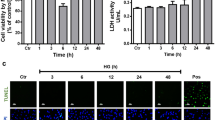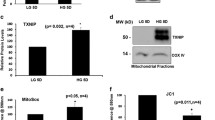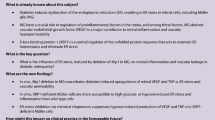Abstract
Müller cells, the primary glial cells are a crucial component of the retinal tissue performing a wide range of functions including maintaining the blood-retinal barrier. Several studies suggest that diabetes leads to Müller cell dysfunction and loss. The pathophysiology of hyperglycemia-induced cellular injury of Müller cells remains only poorly understood. Recently, the concept that translocation of the predominantly cytosolic glycolytic enzyme glyceraldehyde-3-phosphate dehydrogenase (GAPDH) to the nucleus and its accumulation in this cellular compartment alters transcriptional events associated with cell death induction has gained major interest. High glucose conditions induce nuclear translocation and accumulation of GAPDH in the nucleus of Müller cells in vivo and in vitro. With regards to Müller cell dysfunction, the effects of nuclear accumulation of GAPDH are multifaceted. Considering the functional versatility of GAPDH including gene regulation, DNA repair, telomere protection, etc., it is of immense importance to explore possible GAPDH actions to unravel the mysteries around the role of GAPDH in hyperglycemia-induced cellular changes in order to develop novel therapeutic strategies. Therefore, this review focuses on the molecular events associated with the nuclear translocation of GAPDH and how it affects the fate of Müller cells in diabetes.


Similar content being viewed by others
References
Centers for Disease Control and Prevention. National Diabetes Fact Sheet: national estimates and general information on diabetes and prediabetes in the United States, 2011. Atlanta, GA: U.S. Department of Health and Human Services, Centers for Disease Control and Prevention; 2011.
Yau J, Rogers S, Kawasaki R, Lamoureux E, Kowalski J, Bek T, et al. Global prevalence and major risk factors of diabetic retinopathy. Diabetes Care. 2012;35(3):556–64. doi:10.2337/dc11-1909.
Cheung N, Mitchell P, Wong TY. Diabetic retinopathy. Lancet. 2010;376(9735):124–36. doi:10.1016/S0140-6736(09)62124-3.
Distler C, Dreher Z. Glia cells of the monkey retina–II. Müller cells. Vis Res. 1996;36(16):2381–94.
Kannan R, Bao Y, Wang Y, Sarthy V, Kaplowitz N. Protection from oxidant injury by sodium-dependent GSH uptake in retinal Müller cells. Exp Eye Res. 1999;68(5):609–16. doi:10.1006/exer.1998.0639.
Miller R, Dowling J. Intracellular responses of the Müller (glial) cells of mudpuppy retina: their relation to b-wave of the electroretinogram. J Neurophysiol. 1970;33(3):323–41.
Newman E, Frambach D, Odette L. Control of extracellular potassium levels by retinal glial cell K+ siphoning. Science. 1984;225(4667):1174–5.
Reichenbach A, Stolzenburg J, Eberhardt W, Chao T, Dettmer D, Hertz L. What do retinal Müller (glial) cells do for their neuronal ‘small siblings’? J Chem Neuroanat. 1993;66(4):201–13.
Sarthy V. Müller cells in retinal health and disease. Arch Soc Esp Oftalmol. 2000;75(6):367–8.
Schütte M, Werner P. Redistribution of glutathione in the ischemic rat retina. Neurosci Lett. 1998;246(1):53–6.
Tout S, Chan-Ling T, Holländer H, Stone J. The role of Müller cells in the formation of the blood–retinal barrier. Neuroscience. 1993;55(1):291–301.
Poitry-Yamate C, Poitry S, Tsacopoulos M. Lactate released by Müller glial cells is metabolized by photoreceptors from mammalian retina. J Neurosci Off J Soc Neurosci. 1995;15(7):5179–91.
Tsacopoulos M, Magistretti P. Metabolic coupling between glia and neurons. J Neurosci Off J Soc Neurosci. 1996;16:877–85.
Matsui K, Hosoi N, Tachibana M. Active role of glutamate uptake in the synaptic transmission from retinal nonspiking neurons. J Neurosci Off J Soc Neurosci. 1999;19(16):6755–66.
Riepe R, Norenburg M. Müller cell localisation of glutamine synthetase in rat retina. Nature. 1977;268:654–5.
White R, Neal M. The uptake of l-glutamate by the retina. Brain Res. 1976;111(1):79–93.
Newman E, Reichenbach A. The Müller cell: a functional element of the retina. Trends Neurosci. 1996;19(8):307–12.
Dubois-Dauphin M, Poitry-Yamate C, de Bilbao F, Julliard A, Jourdan F, Donati G. Early postnatal Müller cell death leads to retinal but not optic nerve degeneration in NSE-Hu-Bcl-2 transgenic mice. Neuroscience. 2000;95(1):9–21.
Puro D, Mano T. Modulation of calcium channels in human retinal glial cells by basic fibroblast growth factor: a possible role in retinal pathobiology. J Neurosci Off J Soc Neurosci. 1991;11(6):1873–80.
Ward M, Jobling A, Kalloniatis M, Fletcher E. Glutamate uptake in retinal glial cells during diabetes. Diabetologia. 2005;48(2):351–60. doi:10.1007/s00125-004-1639-5.
Abu el Asrar A, Maimone D, Morse P, Gregory S, Reder A. Cytokines in the vitreous of patients with proliferative diabetic retinopathy. Am J Ophthalmol. 1992;114(6):731–6.
Busik J, Mohr S, Grant M. Hyperglycemia-induced reactive oxygen species toxicity to endothelial cells is dependent on paracrine mediators. Diabetes. 2008;57(7):1952–65. doi:10.2337/db07-1520.
Joussen A, Poulaki V, Le M, Koizumi K, Esser C, Janicki H, et al. A central role for inflammation in the pathogenesis of diabetic retinopathy. FASEB J Off Publ Fed Am Soc Exp Biol. 2004;18(12):1450–2. doi:10.1096/fj.03-1476fje.
Mohr S, Xi X, Tang J, Kern T. Caspase activation in retinas of diabetic and galactosemic mice and diabetic patients. Diabetes. 2002;51(4):1172–9.
Vincent J, Mohr S. Inhibition of caspase-1/interleukin-1beta signaling prevents degeneration of retinal capillaries in diabetes and galactosemia. Diabetes. 2007;56(1):224–30. doi:10.2337/db06-0427.
Yego E, Vincent J, Sarthy V, Busik J, Mohr S. Differential regulation of high glucose-induced glyceraldehyde-3-phosphate dehydrogenase nuclear accumulation in Müller cells by IL-1beta and IL-6. Invest Ophthalmol Vis Sci. 2009;50(4):1920–8. doi:10.1167/iovs.08-2082.
Kusner L, Sarthy V, Mohr S. Nuclear translocation of glyceraldehyde-3-phosphate dehydrogenase: a role in high glucose-induced apoptosis in retinal Müller cells. Invest Ophthalmol Vis Sci. 2004;45(5):1553–61.
Barber R, Harmer D, Coleman R, Clark B. GAPDH as a housekeeping gene: analysis of GAPDH mRNA expression in a panel of 72 human tissues. Physiol Genomics. 2005;21:389–95. doi:10.1152/physiolgenomics.00025.2005.
Tisdale E. Glyceraldehyde-3-phosphate dehydrogenase is phosphorylated by protein kinase Ciota/lambda and plays a role in microtubule dynamics in the early secretory pathway. J Biol Chem. 2002;277(5):3334–41. doi:10.1074/jbc.M109744200.
Tisdale E, Azizi F, Artalejo C. Rab2 utilizes glyceraldehyde-3-phosphate dehydrogenase and protein kinase C{iota} to associate with microtubules and to recruit dynein. J Biol Chem. 2009;284(9):5876–84. doi:10.1074/jbc.M807756200.
Andrade J, Pearce S, Zhao H, Barroso M. Interactions among p22, glyceraldehyde-3-phosphate dehydrogenase and microtubules. Biochem J. 2004;384(Pt 2):327–36. doi:10.1042/bj20040622.
Tisdale E, Kelly C, Artalejo C. Glyceraldehyde-3-phosphate dehydrogenase interacts with Rab2 and plays an essential role in endoplasmic reticulum to Golgi transport exclusive of its glycolytic activity. J Biol Chem. 2004;279(52):54046–52. doi:10.1074/jbc.M409472200.
Harada N, Yasunaga R, Higashimura Y, Yamaji R, Fujimoto K, Moss J, et al. Glyceraldehyde-3-phosphate dehydrogenase enhances transcriptional activity of androgen receptor in prostate cancer cells. J Biol Chem. 2007;282(31):22651–61. doi:10.1074/jbc.M610724200.
Singh R, Green M. Sequence-specific binding of transfer RNA by glyceraldehyde-3-phosphate dehydrogenase. Science. 1993;259(5093):365–8.
Rodríguez-Pascual F, Redondo-Horcajo M, Magán-Marchal N, Lagares D, Martínez-Ruiz A, Kleinert H, et al. Glyceraldehyde-3-phosphate dehydrogenase regulates endothelin-1 expression by a novel, redox-sensitive mechanism involving mRNA stability. Mol Cell Biol. 2008;28(23):7139–55. doi:10.1128/mcb.01145-08.
Bonafé N, Gilmore-Hebert M, Folk N, Azodi M, Zhou Y, Chambers S. Glyceraldehyde-3-phosphate dehydrogenase binds to the AU-Rich 3′ untranslated region of colony-stimulating factor-1 (CSF-1) messenger RNA in human ovarian cancer cells: possible role in CSF-1 posttranscriptional regulation and tumor phenotype. Cancer Res. 2005;65(9):3762–71. doi:10.1158/0008-5472.can-04-3954.
Zhou Y, Yi X, Jn S, Bonafe N, Gilmore-Hebert M, McAlpine J, et al. The multifunctional protein glyceraldehyde-3-phosphate dehydrogenase is both regulated and controls colony-stimulating factor-1 messenger RNA stability in ovarian cancer. Mol Cancer Res: MCR. 2008;6(8):1375–84. doi:10.1158/1541-7786.mcr-07-2170.
Backlund M, Paukku K, Daviet L, De Boer R, Valo E, Hautaniemi S, et al. Posttranscriptional regulation of angiotensin II type 1 receptor expression by glyceraldehyde 3-phosphate dehydrogenase. Nucleic Acids Res. 2009;37(7):2346–58. doi:10.1093/nar/gkp098.
Carujo S, Estanyol J, Ejarque A, Agell N, Bachs O, Pujol M. Glyceraldehyde 3-phosphate dehydrogenase is a SET-binding protein and regulates cyclin B-cdk1 activity. Oncogene. 2006;25:4033–42. doi:10.1038/sj.onc.1209433.
Zheng L, Roeder R, Luo Y. S phase activation of the histone H2B promoter by OCA-S, a coactivator complex that contains GAPDH as a key component. Cell. 2003;114(2):255–66.
Mansur N, Meyer-Siegler K, Wurzer J, Sirover M. Cell cycle regulation of the glyceraldehyde-3-phosphate dehydrogenase/uracil DNA glycosylase gene in normal human cells. Nucleic Acids Res. 1993;21(4):993–8.
Ronai Z. Glycolytic enzymes as DNA binding proteins. Int J Biochem. 1993;25(7):1073–6.
Azam S, Jouvet N, Jilani A, Vongsamphanh R, Yang X, Yang S, et al. Human glyceraldehyde-3-phosphate dehydrogenase plays a direct role in reactivating oxidized forms of the DNA repair enzyme APE1. J Biol Chem. 2008;283(45):30632–41. doi:10.1074/jbc.M801401200.
Sundararaj K, Wood R, Ponnusamy S, Salas A, Szulc Z, Bielawska A, et al. Rapid shortening of telomere length in response to ceramide involves the inhibition of telomere binding activity of nuclear glyceraldehyde-3-phosphate dehydrogenase. J Biol Chem. 2004;279(7):6152–62. doi:10.1074/jbc.M310549200.
Demarse N, Ponnusamy S, Spicer E, Apohan E, Baatz J, Ogretmen B, et al. Direct binding of glyceraldehyde 3-phosphate dehydrogenase to telomeric DNA protects telomeres against chemotherapy-induced rapid degradation. J Mol Biol. 2009;394(4):789–803. doi:10.1016/j.jmb.2009.09.062.
Patterson R, van Rossum D, Kaplin A, Barrow R, Snyder S. Inositol 1,4,5-trisphosphate receptor/GAPDH complex augments Ca2+ release via locally derived NADH. Proc Natl Acad Sci USA. 2005;102(5):1357–9. doi:10.1073/pnas.0409657102.
Ravichandran V, Seres T, Moriguchi T, Thomas J, Johnston R. S-thiolation of glyceraldehyde-3-phosphate dehydrogenase induced by the phagocytosis-associated respiratory burst in blood monocytes. J Biol Chem. 1994;269(40):25010–5.
Du X, Matsumura T, Edelstein D, Rossetti L, Zsengellér Z, Szabó C, et al. Inhibition of GAPDH activity by poly(ADP-ribose) polymerase activates three major pathways of hyperglycemic damage in endothelial cells. J Clin Invest. 2003;112(7):1049–57. doi:10.1172/jci18127.
Devalaraja-Narashimha K, Padanilam B. PARP-1 inhibits glycolysis in ischemic kidneys. J Am Soc Nephrol: JASN. 2009;20(1):95–103. doi:10.1681/asn.2008030325.
Tarze A, Deniaud A, Le Bras M, Maillier E, Molle D, Larochette N, et al. GAPDH, a novel regulator of the pro-apoptotic mitochondrial membrane permeabilization. Oncogene. 2007;26(18):2606–20. doi:10.1038/sj.onc.1210074.
Colell A, Ricci J-E, Tait S, Milasta S, Maurer U, Bouchier-Hayes L, et al. GAPDH and autophagy preserve survival after apoptotic cytochrome c release in the absence of caspase activation. Cell. 2007;129(5):983–97. doi:10.1016/j.cell.2007.03.045.
Saunders P, Chalecka-Franaszek E, Chuang D. Subcellular distribution of glyceraldehyde-3-phosphate dehydrogenase in cerebellar granule cells undergoing cytosine arabinoside-induced apoptosis. J Neurochem. 1997;69(5):1820–8.
Sawa A, Khan A, Hester L, Snyder S. Glyceraldehyde-3-phosphate dehydrogenase: nuclear translocation participates in neuronal and nonneuronal cell death. Proc Natl Acad Sci USA. 1997;94(21):11669–74.
Ishitani R, Tanaka M, Sunaga K, Katsube N, Chuang D. Nuclear localization of overexpressed glyceraldehyde-3-phosphate dehydrogenase in cultured cerebellar neurons undergoing apoptosis. Mol Pharmacol. 1998;53(4):701–7.
Kragten E, Lalande I, Zimmermann K, Roggo S, Schindler P, Muller D, et al. Glyceraldehyde-3-phosphate dehydrogenase, the putative target of the antiapoptotic compounds CGP 3466 and R-(−)-deprenyl. J Biol Chem. 1998;273(10):5821–8.
Carlile G, Chalmers-Redman R, Tatton N, Pong A, Borden K, Tatton W. Reduced apoptosis after nerve growth factor and serum withdrawal: conversion of tetrameric glyceraldehyde-3-phosphate dehydrogenase to a dimer. Mol Pharmacol. 2000;57(2):2–12.
Dastoor Z, Dreyer J. Potential role of nuclear translocation of glyceraldehyde-3-phosphate dehydrogenase in apoptosis and oxidative stress. J Cell Sci. 2001;114:1643–53.
Hara M, Agrawal N, Kim S, Cascio M, Fujimuro M, Ozeki Y, et al. S-nitrosylated GAPDH initiates apoptotic cell death by nuclear translocation following SIAH1 binding. Nat Cell Biol. 2005;7:665–74. doi:10.1038/ncb1268.
Sen N, Hara M, Ahmad A, Cascio M, Kamiya A, Ehmsen J, et al. GOSPEL: a neuroprotective protein that binds to GAPDH upon S-nitrosylation. Neuron. 2009;63(1):81–91. doi:10.1016/j.neuron.2009.05.024.
Sourisseau T, Desbois C, Debure L, Bowtell D, Cato A, Schneikert J, et al. Alteration of the stability of Bag-1 protein in the control of olfactory neuronal apoptosis. J Cell Sci. 2001;114(Pt 7):1409–16.
Fiucci G, Beaucourt S, Duflaut D, Lespagnol A, Stumptner-Cuvelette P, Géant A, et al. SIAH-1b is a direct transcriptional target of p53: identification of the functional p53 responsive element in the siah-1b promoter. Proc Natl Acad Sci USA. 2004;101(10):3510–5. doi:10.1073/pnas.0400177101.
Polekhina G, House C, Traficante N, Mackay J, Relaix F, Sassoon D, et al. SIAH ubiquitin ligase is structurally related to TRAF and modulates TNF-alpha signaling. Nat Struct Biol. 2002;9(1):68–75. doi:10.1038/nsb743.
House C, Frew I, Huang H-L, Wiche G, Traficante N, Nice E, et al. A binding motif for SIAH ubiquitin ligase. Proc Natl Acad Sci USA. 2003;100(6):3101–6. doi:10.1073/pnas.0534783100.
House C, Hancock N, Möller A, Cromer B, Fedorov V, Bowtell D, et al. Elucidation of the substrate binding site of SIAH ubiquitin ligase. Structure (London, England: 1993). 2006;14(4):695–701. doi:10.1016/j.str.2005.12.013.
Sen N, Hara M, Kornberg M, Cascio M, Bae B-I, Shahani N, et al. Nitric oxide-induced nuclear GAPDH activates p300/CBP and mediates apoptosis. Nat Cell Biol. 2008;10:866–73. doi:10.1038/ncb1747.
Kornberg M, Sen N, Hara M, Juluri K, Nguyen J, Snowman A, et al. GAPDH mediates nitrosylation of nuclear proteins. Nat Cell Biol. 2010;12(11):1094–100. doi:10.1038/ncb2114.
Yego E, Mohr S. SIAH-1 protein is necessary for high glucose-induced glyceraldehyde-3-phosphate dehydrogenase nuclear accumulation and cell death in Müller cells. J Biol Chem. 2010;285:3181–90. doi:10.1074/jbc.M109.083907.
Creagh E, Conroy H, Martin S. Caspase-activation pathways in apoptosis and immunity. Immunol Rev. 2003;193:10–21.
Madsen-Bouterse S, Mohammad G, Kowluru R. Glyceraldehyde-3-phosphate dehydrogenase in retinal microvasculature: implications for the development and progression of diabetic retinopathy. Invest Ophthalmol Vis Sci. 2010;51(3):1765–72. doi:10.1167/iovs.09-4171.
Krady J, Basu A, Allen C, Xu Y, LaNoue K, Gardner T, et al. Minocycline reduces proinflammatory cytokine expression, microglial activation, and caspase-3 activation in a rodent model of diabetic retinopathy. Diabetes. 2005;54(5):1559–65.
Jeanclos E, Krolewski A, Skurnick J, Kimura M, Aviv H, Warram J, et al. Shortened telomere length in white blood cells of patients with IDDM. Diabetes. 1998;47(3):482–6.
González M, Sanz I, Silva V, Asenjo S, Gleisner A, Bustamante M. Differential modulation by native and glycated low density lipoproteins of peripheral blood mononuclear cells proliferation induced by phytohemagglutinin in insulin-dependent diabetes mellitus patients. Clin Chim Acta Int J Clin Chem. 2000;293(1–2):223–8.
Uziel O, Singer J, Danicek V, Sahar G, Berkov E, Luchansky M, et al. Telomere dynamics in arteries and mononuclear cells of diabetic patients: effect of diabetes and of glycemic control. Exp Gerontol. 2007;42(10):971–8. doi:10.1016/j.exger.2007.07.005.
Acknowledgments
This manuscript was supported by NIH/NEI EY-017268 (SM).
Author information
Authors and Affiliations
Corresponding author
Rights and permissions
About this article
Cite this article
Jayaguru, P., Mohr, S. Nuclear GAPDH: changing the fate of Müller cells in diabetes. j ocul biol dis inform 4, 34–41 (2011). https://doi.org/10.1007/s12177-012-9085-y
Received:
Accepted:
Published:
Issue Date:
DOI: https://doi.org/10.1007/s12177-012-9085-y




